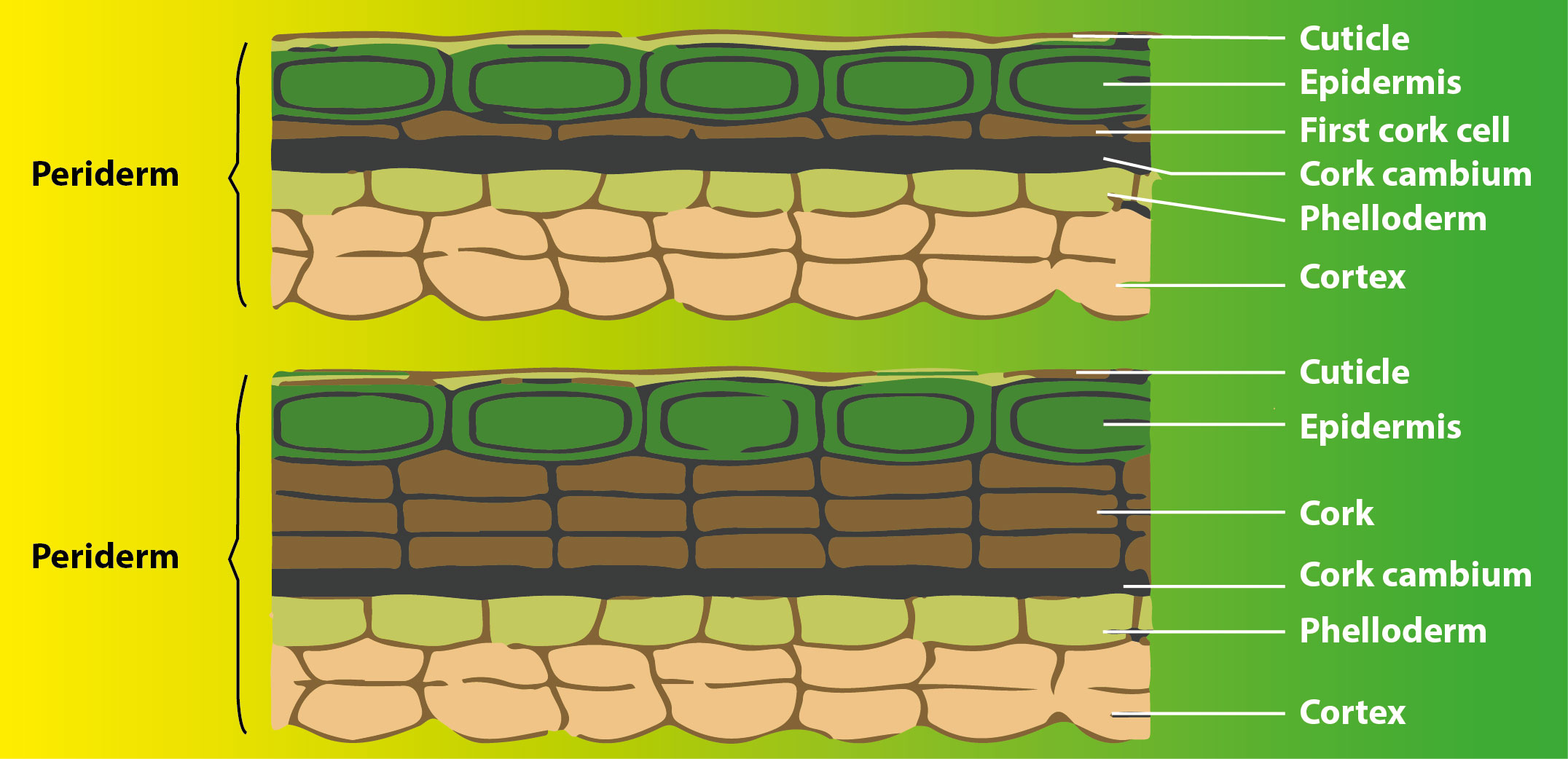Answer
396.9k+ views
Hint: It refers to the collective term wanting to signify phellogen, phellem, and phelloderm during a plant stem. It's formed in plants, mainly occurring to exchange the prevailing epidermis. It's composed of thin-walled, narrow, and rectangular cells.
Complete answer:
A. Vascular cambium – produces secondary vascular tissues and ray parenchyma.
B. Fascicular cambium – a strip of cambium present between the xylem and phloem of a vascular strand is named fascicular cambium. It involves secondary growth.
C. Phellogen – a hoop of cambium formed within the cortex of dicot stem, by the dedifferentiation of parenchyma is named Phellogen. it's involved within the formation of the periderm.
D. Intrafascicular cambium - a strip of cambium present between the xylem and phloem of a vascular strand is named fascicular cambium. It involves secondary growth.
Additional information: The formation of periderm occurs during secondary growth. During this process, to exchange the broken outer epidermal layer and therefore the cortical layer, the cells of the cortex turn meristematic.

Thus, cork cambium or phellogen is made. The phellogen comprises slightly walled, restricted, and rectangular cells. Later on, the phellogen cuts off cells on either side. The cells of the external side produce the phellem or plug which because of the statement of suberin in its cell layer is impenetrable to water. Additionally, the inward side structures the optional cortex or phelloderm which is particularly parenchymatous in nature.
So the correct answer is ‘Phellogen’.
Note: Analysis of mature tuber periderm, however, might not produce easily identifiable phellogen or phelloderm. A study of all three periderm cell types in immature and mature periderm was needed to work out maturational changes. Recently have these periderm cell structures been plainly shown for simpler identification and related morphological depiction. The suberization measures engaged with phellem improvement are just halfway described.
Complete answer:
A. Vascular cambium – produces secondary vascular tissues and ray parenchyma.
B. Fascicular cambium – a strip of cambium present between the xylem and phloem of a vascular strand is named fascicular cambium. It involves secondary growth.
C. Phellogen – a hoop of cambium formed within the cortex of dicot stem, by the dedifferentiation of parenchyma is named Phellogen. it's involved within the formation of the periderm.
D. Intrafascicular cambium - a strip of cambium present between the xylem and phloem of a vascular strand is named fascicular cambium. It involves secondary growth.
Additional information: The formation of periderm occurs during secondary growth. During this process, to exchange the broken outer epidermal layer and therefore the cortical layer, the cells of the cortex turn meristematic.

Thus, cork cambium or phellogen is made. The phellogen comprises slightly walled, restricted, and rectangular cells. Later on, the phellogen cuts off cells on either side. The cells of the external side produce the phellem or plug which because of the statement of suberin in its cell layer is impenetrable to water. Additionally, the inward side structures the optional cortex or phelloderm which is particularly parenchymatous in nature.
So the correct answer is ‘Phellogen’.
Note: Analysis of mature tuber periderm, however, might not produce easily identifiable phellogen or phelloderm. A study of all three periderm cell types in immature and mature periderm was needed to work out maturational changes. Recently have these periderm cell structures been plainly shown for simpler identification and related morphological depiction. The suberization measures engaged with phellem improvement are just halfway described.
Recently Updated Pages
How many sigma and pi bonds are present in HCequiv class 11 chemistry CBSE

Why Are Noble Gases NonReactive class 11 chemistry CBSE

Let X and Y be the sets of all positive divisors of class 11 maths CBSE

Let x and y be 2 real numbers which satisfy the equations class 11 maths CBSE

Let x 4log 2sqrt 9k 1 + 7 and y dfrac132log 2sqrt5 class 11 maths CBSE

Let x22ax+b20 and x22bx+a20 be two equations Then the class 11 maths CBSE

Trending doubts
Fill the blanks with the suitable prepositions 1 The class 9 english CBSE

At which age domestication of animals started A Neolithic class 11 social science CBSE

Which are the Top 10 Largest Countries of the World?

Give 10 examples for herbs , shrubs , climbers , creepers

Difference between Prokaryotic cell and Eukaryotic class 11 biology CBSE

Difference Between Plant Cell and Animal Cell

Write a letter to the principal requesting him to grant class 10 english CBSE

Change the following sentences into negative and interrogative class 10 english CBSE

Fill in the blanks A 1 lakh ten thousand B 1 million class 9 maths CBSE



